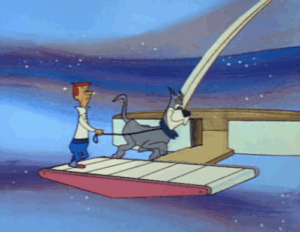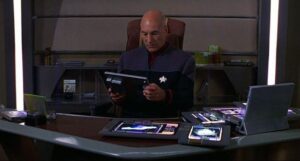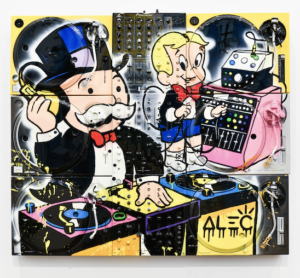Do you remember those stories that whisked you away to magical places when you were a kid? The ones that made you believe anything was possible?

If you are of a certain age like me, perhaps the futuristic world of “The Jetsons” with their flying cars that soared through the skies comes to mind. 🚀
Or, the awe-inspiring capabilities of the “6-Million Dollar Man” and the “Bionic Woman” with their bionic limbs and supersonic senses. 🦾
And who could forget the profound impact of “2001 A Space Odyssey ” with its cautionary tale of humans and technology? 🤖
These tales aren’t just tales; they’re the sparks that ignited the flames of innovation and transformation in our world.
“To imagine the future is to shape it.”
Stories have always held a special place in our collective consciousness. They are more than just words on a page or scenes on a screen; they’re the seeds of inspiration, and the catalysts of change, that influence the architects of our future.
Think about those seemingly far-fetched stories from the 60s and 70s, or the controversial artworks that were seen as inappropriate or impossible to understand. They weren’t just fluff or entertainment, in fact, they have shaped the world we live in today.
From the Renaissance to Modernism 🎨, from Stanley Kubrick’s Space Odyssey 👨🏻🚀 to George Orwell’s dystopian 1984 world 📹, these narratives weren’t just entertainment – they were blueprints for our reality.
The Prophecies of the Past

Much of the technology featured in the original Star Trek is today part of pop culture. Terms and technology like Phasers, Transporters and Communicators have become part of our folklore.
Gene Roddenberry’s Star Trek not only celebrated space exploration but also embodied the aspiration for a united humanity. Today, we see echoes of this hope in real-world manifestations like the International Space Station (ISS), the World Monetary Fund and the United Nations.
With “Do Androids Dream of Electric Sheep?” Philip K. Dick delved deep into the complex relationship between artificial intelligence and humanity, a dialogue that resonates intensely in our current AI-driven age.
On the other hand, tales like Aldous Huxley’s Brave New World and Margaret Atwood’s The Handmaid’s Tale presented stark warnings about the possible detours of human progress.
Amidst the whirlwind of today’s interconnected world, it’s fascinating how the echoes of our past stories continue to reverberate, shaping our present and possibly even our future.
In the digital realm, where cyberpunk aesthetics merge with daily life, there’s a subtle reminder of the persistent tension between individuality and the looming presence of powerful corporations. It’s as if William Gibson’s Neuromancer isn’t just a novel but a prophetic glimpse into our world today.
For ages, tales of far-off worlds and artistic creations have been more than just entertainment — they’ve been our dreams and warnings, all rolled into one.
These stories, from the pages of books to the strokes of artists’ brushes, aren’t just fleeting tales for entertainment. They’re the architects of societies, the blueprint for our technologies, and the fuel for our collective imagination.
But in our era of hyperconnectivity, where every tweet and video is a potential megaphone, it can often feel like the world is drowning in a sea of bad news. The endless scroll of negativity can be overwhelming, leaving us wondering if there’s a way to change the narrative.
So, here’s a daring thought…
What if we became the authors of brighter, bolder stories?
What if we, like the artists and writers of the past, painted a vision of the future that excites us?
What if we harnessed the power of storytelling not just to reflect our world but to shape it?
An Exercise in Cultivating Thought Leadership
In this very moment, you have the opportunity to be a part of this narrative shift. Your voice, your thoughts, and your stories can be the sparks that light up the path to a future we’re genuinely excited about.
Imagine the stories we tell today as seeds we plant for tomorrow.
Imagine if our favourite books, movies, and paintings were like a mirror, reflecting our hopes and fears back at us.
Just like a storyteller around a campfire, the tales we share now could shape the world of tomorrow. So, what kind of stories do we want to tell? What stories are you speaking into existence? What future are you creating from the seeds you plant today?
In Part #2, Artists and Experts in Shaping Tomorrow, we delve into how artistic movements and diverse perspectives continue to inspire today’s visionaries.
We’ll also explore how you, yes you, can step into your power as a thought leader and craft the future through your unique voice.
In the meantime, ponder the stories you’re planting today and the future they’ll create. Together, we’re authoring a brighter, bolder tomorrow.
[gdlr_divider type=”solid” size=”80%” ]
In the grand tapestry of existence, stories are the threads that weave societies, shape beliefs, and sculpt the future.
Our upcoming Masterclass, The Ultimate Guide to Thought Leadership Through Storytelling, is your loom, ready to turn your ideas into powerful narratives.
Join us on this creative voyage and learn how to fuse the enchantment of idea-centric storytelling with the prowess of a thought leader. Become the thought leader who leads the way. Enroll today to inspire, influence, and impact.


